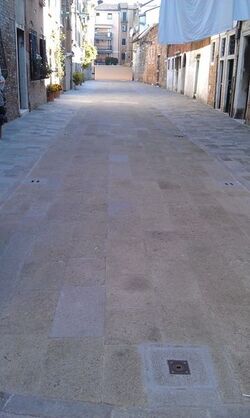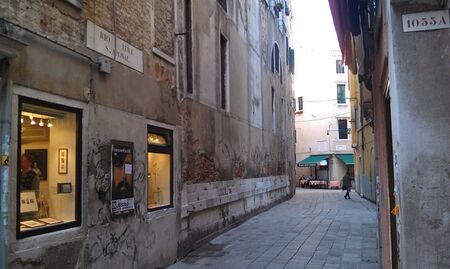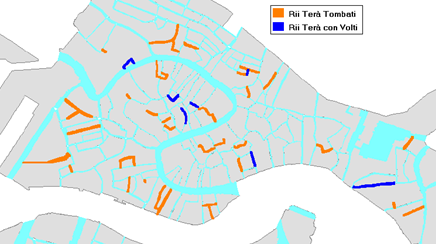Rio Terà: Difference between revisions
Jump to navigation
Jump to search
No edit summary |
No edit summary |
||
| Line 1: | Line 1: | ||
{{Expand}} | {{Expand}} | ||
''This page provides information about Rio terà | ''This page provides information about a typical Rio terà. For information pertaining to Rio terà as a canal, see [[Rii Tera]].'' | ||
[[File:Rio_tera_2.jpg|right|thumb|250 px|The paved area that was once a canal can be seen by the different pavement patter]] | [[File:Rio_tera_2.jpg|right|thumb|250 px|The paved area that was once a canal can be seen by the different pavement patter]] | ||
''Rio Terà'' is the denomination for a street that was once a [[Canal]]. The two ways in which canals are shut down are called ''Rii Terà Tombati'' and ''Rii Terà con Volti''. ''Rii Terà Tombati'' is the filling in of a canal with dirt and gravel, then [[Stone Pavement|paving]] over the surface. ''Rii Terà con Volti'' is the capping of a canal, allowing water to still flow underneath the pavement. There are 50 ''Rio terà'' in Venice.<ref>Joseph Adam Zsofka et al., Hydrodynamics of the Inner Canals of Venice, 1999)</ref> | ''Rio Terà'' is the denomination for a street that was once a [[Canal]]. The two ways in which canals are shut down are called ''Rii Terà Tombati'' and ''Rii Terà con Volti''. ''Rii Terà Tombati'' is the filling in of a canal with dirt and gravel, then [[Stone Pavement|paving]] over the surface. ''Rii Terà con Volti'' is the capping of a canal, allowing water to still flow underneath the pavement. There are 50 ''Rio terà'' in Venice.<ref>Joseph Adam Zsofka et al., Hydrodynamics of the Inner Canals of Venice, 1999)</ref> | ||
| Line 7: | Line 7: | ||
[[File:Rio_tera.jpg|left|thumb|450 px|Rio Terà S. Aponal]] | [[File:Rio_tera.jpg|left|thumb|450 px|Rio Terà S. Aponal]] | ||
{{-}} | {{-}} | ||
==Types of Rii Terà== | |||
[[File:Rii_Tera.png|right|thumb|1000px|]] | |||
* Rii Terà Tombati – These are canals that have been completely filled in. Because there is absolutely no water flowing in a rii tera tombati they do not affect the flow of any adjacent canal. So when a rii tera tombati intersects a flowing canal the two segments are treated as one. | |||
* Rii Terà con Volti – These are canals that are filled in, but have flowing water underneath the layer of gravel, dirt and sand. Because there is water flowing in a rii tera con volti they do affect the flow of any adjacent canals. So the rii tera con volti is treated like any other canal with flowing water, and when intersecting another flowing canal a new segment is created.<ref>[www.wpi.edu/.../Hydrodynamics/E99_Presentation-Hydrodynamics.PPT "Hydrodynamics of the Inner Venetian Canals"]. WPI. www.wpi.edu/.../Hydrodynamics/E99_Presentation-Hydrodynamics.PPT. Retrieved 2010.</ref> | |||
== See Also == | == See Also == | ||
Revision as of 14:38, 16 October 2013
| Please help improve this article by expanding it. |
This page provides information about a typical Rio terà. For information pertaining to Rio terà as a canal, see Rii Tera.

Rio Terà is the denomination for a street that was once a Canal. The two ways in which canals are shut down are called Rii Terà Tombati and Rii Terà con Volti. Rii Terà Tombati is the filling in of a canal with dirt and gravel, then paving over the surface. Rii Terà con Volti is the capping of a canal, allowing water to still flow underneath the pavement. There are 50 Rio terà in Venice.[1]

Types of Rii Terà

- Rii Terà Tombati – These are canals that have been completely filled in. Because there is absolutely no water flowing in a rii tera tombati they do not affect the flow of any adjacent canal. So when a rii tera tombati intersects a flowing canal the two segments are treated as one.
- Rii Terà con Volti – These are canals that are filled in, but have flowing water underneath the layer of gravel, dirt and sand. Because there is water flowing in a rii tera con volti they do affect the flow of any adjacent canals. So the rii tera con volti is treated like any other canal with flowing water, and when intersecting another flowing canal a new segment is created.[2]
See Also
| |||||